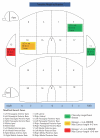Transatlantic Consensus Group on active surveillance and focal therapy for prostate cancer
- PMID: 22077593
- PMCID: PMC3682487
- DOI: 10.1111/j.1464-410X.2011.10633.x
Transatlantic Consensus Group on active surveillance and focal therapy for prostate cancer
Abstract
What's known on the subject? and What does the study add? Active surveillance for prostate cancer is gaining increasing acceptance for low risk prostate cancer. Focal therapy is an emerging tissue preservation strategy that aims for treat only areas of cancer. Early phase trials have shown that side-effects can be significantly reduced using focal therapy. There is significant uncertainty in both active surveillance and focal therapy. This consensus group paper provides a road-map for clinical practice and research for both tissue-preserving strategies in the areas of patient population, tools for risk stratification and cancer localisation, treatment interventions as well as comparators and outcome measures in future comparative trials.
Objective: To reach consensus on key issues for clinical practice and future research in active surveillance and focal therapy in managing localized prostate cancer.
Patients and methods: A group of expert urologists, oncologists, radiologists, pathologists and computer scientists from North America and Europe met to discuss issues in patient population, interventions, comparators and outcome measures to use in both tissue-preserving strategies of active surveillance and focal therapy. Break-out sessions were formed to provide agreement or highlight areas of disagreement on individual topics which were then collated by a writing group into statements that formed the basis of this report and agreed upon by the whole Transatlantic Consensus Group.
Results: The Transatlantic group propose that emerging diagnostic tools such as precision imaging and transperineal prostate mapping biopsy can improve prostate cancer care. These tools should be integrated into prostate cancer management and research so that better risk stratification and more effective treatment allocation can be applied. The group envisaged a process of care in which active surveillance, focal therapy, and radical treatments lie on a continuum of complementary therapies for men with a range of disease grades and burdens, rather than being applied in the mutually exclusive and competitive way they are now.
Conclusion: The changing landscape of prostate cancer epidemiology requires the medical community to re-evaluate the entire prostate cancer diagnostic and treatment pathway in order to minimize harms resulting from over-diagnosis and over-treatment. Precise risk stratification at every point in this pathway is required alongside paradigm shifts in our thinking about what constitutes cancer in the prostate.
© 2011 THE AUTHORS. BJU INTERNATIONAL © 2011 BJU INTERNATIONAL.
Figures




References
-
- Esserman L, Shieh Y, Thompson I. Rethinking screening for breast cancer and prostate cancer. JAMA. 2009;302:1685–92. - PubMed
-
- Schröder FH, Hugosson J, Roobol MJ, et al. Screening and prostate-cancer mortality in a randomized European study. N Engl J Med. 2009;360:1320–8. - PubMed
-
- Altekruse SF, Kosary CL, Krapcho M, et al., editors. SEER Cancer Statistics Review, 1975–2007. National Cancer Institute; Bethesda, MD: [Accessed August 2011]. 2010. based on November 2009 SEER data submission, posted to the SEER web site, 2010. Available at: http://seer.cancer.gov/csr/1975_2007/
-
- Onik G, Miessau M, Bostwick DG. Three-dimensional prostate mapping biopsy has a potentially significant impact on prostate cancer management. J Clin Oncol. 2009;27:4321–6. - PubMed
-
- Ahmed HU, Pendse D, Illing R, Allen C, van der Meulen JH, Emberton M. Will focal therapy become a standard of care for men with localized prostate cancer? Nat Clin Pract Oncol. 2007;4:632–42. - PubMed
MeSH terms
Grants and funding
LinkOut - more resources
Full Text Sources
Medical
Miscellaneous

